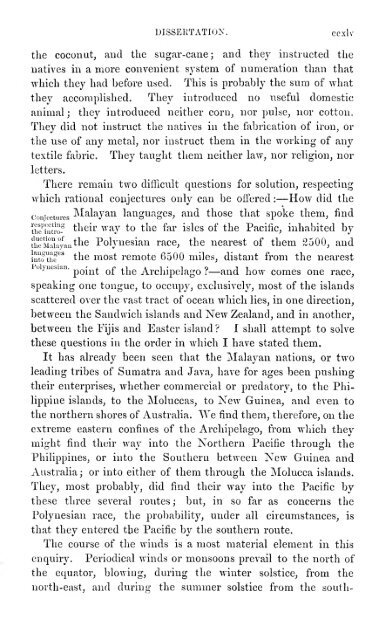A grammar and dictionary of the Malay language : with a preliminary ...
A grammar and dictionary of the Malay language : with a preliminary ...
A grammar and dictionary of the Malay language : with a preliminary ...
Create successful ePaper yourself
Turn your PDF publications into a flip-book with our unique Google optimized e-Paper software.
DISSERTATION. ccxlv<br />
<strong>the</strong> coconut, <strong>and</strong> <strong>the</strong> sugar-cane; <strong>and</strong> <strong>the</strong>y instructed <strong>the</strong><br />
natives in a more convenient system <strong>of</strong> numeration than that<br />
which <strong>the</strong>y had before used. This is probably <strong>the</strong> sura <strong>of</strong> what<br />
<strong>the</strong>y accomplished. They introduced no useful domestic<br />
animal; <strong>the</strong>y introduced nei<strong>the</strong>r corn, nor pulse, nor cotton.<br />
They did not instruct <strong>the</strong> natives in <strong>the</strong> fabrication <strong>of</strong> iron, or<br />
<strong>the</strong> use <strong>of</strong> any metal, nor instruct <strong>the</strong>m in <strong>the</strong> working <strong>of</strong> any<br />
textile fabric. They taught <strong>the</strong>m nei<strong>the</strong>r law, nor religion, nor<br />
letters.<br />
There remain two difficult questions for solution, respecting<br />
which rational conjectures only can be <strong>of</strong>fered :—How did <strong>the</strong><br />
<strong>Malay</strong>an <strong>language</strong>s,<br />
Conjectures <strong>and</strong> those that spoke <strong>the</strong>m, find<br />
<strong>the</strong>^ii^tro? <strong>the</strong>ir way to <strong>the</strong> far isles <strong>of</strong> <strong>the</strong> Pacific, inhabited by<br />
<strong>the</strong>M'Sayan<strong>the</strong> Polynesian race, <strong>the</strong> nearest <strong>of</strong> <strong>the</strong>m 2500, <strong>and</strong><br />
into tSr^ <strong>the</strong> most remote 6500 miles, distant from <strong>the</strong> nearest<br />
Polynesian, p^-j^^ q£ ^^iq Archipclago ?—<strong>and</strong> how comes one race,<br />
speaking one tongue, to occupy, exclusively, most <strong>of</strong> <strong>the</strong> isl<strong>and</strong>s<br />
scattered over <strong>the</strong> vast tract <strong>of</strong> ocean which lies, in one direction,<br />
between <strong>the</strong> S<strong>and</strong>wich isl<strong>and</strong>s <strong>and</strong> New Zeal<strong>and</strong>, <strong>and</strong> in ano<strong>the</strong>r,<br />
between <strong>the</strong> Fijis <strong>and</strong> Easter isl<strong>and</strong> ? I shall attempt to solve<br />
<strong>the</strong>se questions in <strong>the</strong> order in which I have stated <strong>the</strong>m.<br />
It has already been seen that <strong>the</strong> <strong>Malay</strong>an nations, or two<br />
leading tribes <strong>of</strong> Sumatra <strong>and</strong> Java, have for ages been pushing<br />
<strong>the</strong>ir enterprises, whe<strong>the</strong>r commercial or predatory, to <strong>the</strong> Phi-<br />
lippine isl<strong>and</strong>s, to <strong>the</strong> Moluccas, to New Guinea, <strong>and</strong> even to<br />
<strong>the</strong> nor<strong>the</strong>rn shores <strong>of</strong> Australia. We find <strong>the</strong>m, <strong>the</strong>refore, on <strong>the</strong><br />
extreme eastern confines <strong>of</strong> <strong>the</strong> Archipelago, from which <strong>the</strong>y<br />
might find <strong>the</strong>ir way into <strong>the</strong> Nor<strong>the</strong>rn Pacific through <strong>the</strong><br />
Philippines, or into <strong>the</strong> Sou<strong>the</strong>rn between New Guinea <strong>and</strong><br />
Australia; or into ei<strong>the</strong>r <strong>of</strong> <strong>the</strong>m through <strong>the</strong> Molucca isl<strong>and</strong>s.<br />
They, most probably, did find <strong>the</strong>ir way into <strong>the</strong> Pacific by<br />
<strong>the</strong>se three several routes; but, in so far as concerns <strong>the</strong><br />
Polynesian race, <strong>the</strong> probability, under all circumstances, is<br />
that <strong>the</strong>y entered <strong>the</strong> Pacific by <strong>the</strong> sou<strong>the</strong>rn route.<br />
The course <strong>of</strong> <strong>the</strong> winds is a most material element in this<br />
enquiry. Periodical winds or monsoons prevail to <strong>the</strong> north <strong>of</strong><br />
<strong>the</strong> equator, blowing, during <strong>the</strong> winter solstice, from <strong>the</strong><br />
north-east, <strong>and</strong> during <strong>the</strong> summer solstice from <strong>the</strong> south-

















